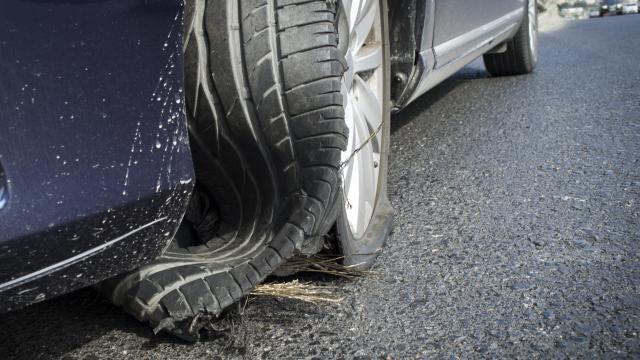One of the first things people learn about driving is how important it is to pay attention to what you’re doing. This means not only keeping your eyes on the road (and the vehicles around you) and watching your speed, but also being aware of how a particular vehicle normally feels when you drive it. (Is it a smooth ride? Can you feel every bump in the road? You get the picture.)
Why does this matter? Because when you know how a car normally drives, it won’t take you as long to notice when something feels “off” — even if it’s subtle, like your tire slowly leaking air. And this is especially important because catching a problem like that early could prevent you from experiencing something more extreme (and definitely noticeable), like a tire blowout.
But a tire gradually losing air is only one cause of a blowout; others happen much faster. Regardless of the cause, here’s what to do if your tire blows out while you’re driving.
What causes a tire to blows out?
When we talk about a tire “blowing out,” it usually refers to the tire bursting suddenly, and then quickly losing air. Under-inflated tires are behind many blowouts. This is because the lack of sufficient air pressure allows the tire to flex beyond its limits and overheat to the point that its rubber loses its bond to the internal fabric and steel cord reinforcement.
Generally speaking, a tire blows out when air is able to escape from it, leaving it unable to support the weight of the vehicle. Some of the more specific causes of a tire blowout include:
- Overloading the vehicle
- Impact damage (depending on the severity of the impact, the blowout can happen either immediately, or after a delay)
- A massive gash or cut in the tire that causes it to lose air quickly
- A small puncture that goes unnoticed, and allows air to slowly leave the tire
What to do when your tire blows out while you’re driving
A tire blowout usually starts with the sound and feeling of the tire popping, then losing air, and hitting the pavement. It’s natural to be startled, but do your best to stay calm. Here’s what to do next:
- Get a tight grip on the steering wheel.
- Don’t hit the brakes (even though that feels like what you should do in the moment).
- Accelerate slightly while steering the car as straight as possible.
- Gently lift your foot off the accelerator to slow down.
- Turn on your emergency lights.
- Carefully make your way to the lane farthest to the left (if you’re driving on a multilane road). Remember to look for passing vehicles as you go.
- Pull over onto the shoulder of the road, completely out of the way of other traffic, and ideally, on level ground.
From there, it largely depends on where the blowout happens, and how comfortable you are changing a tire. But whether you’re calling for assistance or switching the blown tire for your spare, be sure to stay safely out of traffic.

Leave a Reply
You must be logged in to post a comment.